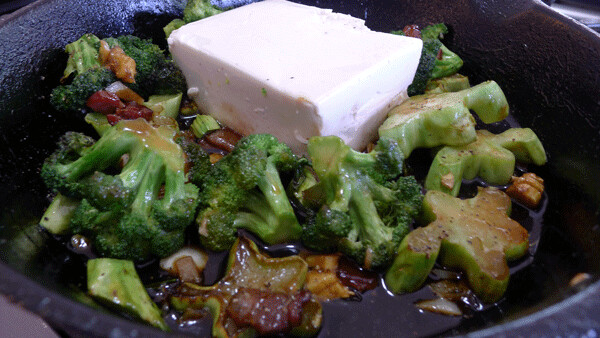Tofu Curious

Two miles from the Las Vegas Strip is the city’s Chinatown district. Unlike the labyrinthine Chinatowns of San Francisco or New York, this neighborhood consists of a laser-straight section of Spring Mountain Road, lined on both sides with double-decker strip malls, roughly half the flashing neon signage on Earth, and an overwhelming diversity of Asian food. The options include familiar themes like noodles, seafood or hot pot, but also an array of niche delicacies served in quirky eateries like Kapit Bahay Filipino Fast Food, Namu Shabu Bar, Spicy Crawfish, Spicy City and, my favorite, Mr. Tofu.
My introduction to tofu came when, as a young idealist, I decided to be a vegetarian in order to save the animals. My dad made me eat “bean curd,” as he called it, so I wouldn’t wither away from protein loss. Thanks partly to bean curd, I didn’t last very long as a vegetarian. And thanks to experiences like mine, tofu has a reputation of being the bland epitome of the supposedly unsatisfying nature of vegetarian dishes in general.
The playbook for cooking tofu is that it is a blank slate that will conform to its surroundings. But the downside of this chameleon-like adaptability is that if tofu is cooked with a lackluster stir-fry and left among a mess of overcooked veggies, it will taste like a lackluster mess. But if you cook it with a rich sauce, your opinion might change. And if you cook it with a slice of bacon, you may well learn to love it.
Asian cooks don’t necessarily look at tofu as a meat substitute, so it’s totally normal to cook tofu and meat in the same dish. Mr. Tofu, which closed in 2006, specialized in a Korean dish called sundubu jjigae, a spicy soup built around blinding white chunks of silken tofu, aka sundubu, with choice of pork, chicken, beef or seafood, and with a half-cooked egg on top.
Silken tofu has a delicate, flan-like texture, so cooks usually add it when a dish is nearly complete, or it will disintegrate. This makes it difficult to follow the firm tofu playbook - namely, cook it long enough that it absorbs the flavors around it - with silken tofu. But the game is the same. Instead of cutting the tofu into pieces and stirring them into the dish, simply add a whole chunk of tofu to the finished product, and use it like a condiment. As you spoon the sauce and whatnot into your mouth, make sure to include a bit of tofu. As such, it functions like a serving of plain rice or noodles that assumes the flavor of a curry when you mix them together and eat.
In sundubu jjigae, the pillowy chunks of tofu gleam in the red broth, and fall apart deliciously in your mouth as you chew it with the soup. I would tell you how to make it, but this column is for the tofu-curious, and that’s an expert-level dish.
Instead, let’s get our feet wet by adding a block of tofu, or part of one, to a pot of instant ramen. If you want to invoke the history and flavors of sundubu jjigae, try to find a packet of Nongshim ramen, which comes in several spicy flavors. You can find it in any Asian store and some American supermarkets, too. Meanwhile, pick up a box of silken tofu. To make a cheater’s sundubu jjigae, follow the directions on the package. After adding the noodles and flavor packets, add half a block of sundubu, and perhaps an egg, to the simmering pot.
Whatever you try, you should be guided by the fact that silken tofu is about as fragile as a raw egg. But unlike an egg it doesn’t get any more solid as it cooks. Without a soup to help support its mass, a hunk at the mercy of gravity is all the more delicate. Add the silken tofu last, so it can do its falling apart while you eat it. And serve it with a sauce that is strong enough to make you seek the occasional refuge in its forgiving, lily white embrace. And whenever possible, serve it with bacon.
Here is a recipe for tofu with broccoli and squash in a Chinese-style sauce. Like Las Vegas’ Chinatown, this recipe has flavors from other Asian cuisines.
Tofu with Broccoli and Bacon in “Chinese” Sauce
Given that tofu absorbs the flavors around it, cooking with bacon is a no-brainer. It’s not vegetarian, of course. But at the same time, it’s a way to stretch a single slice of bacon into a tasty, protein-rich meal. Seriously, vegetarians, you know you want to; just one slice of bacon, and it will be the best tofu you ever tried. That said, you are welcome to skip the bacon.
This recipe calls for broccoli, but any seasonal vegetables work, including cauliflower, summer squash, winter squash.
Serves 2
1 block silken tofu, kept in the package until the last minute for its own protection
1 slice bacon, preferably thick (if skipping bacon, substitute a tablespoon of cooking oil)
1 broccoli crown, broken into florets, stems sliced
1 tablespoon sesame oil
1 clove garlic, smashed
1 garlic-clove-sized piece of ginger, sliced
2 tablespoons oyster sauce
2 teaspoons fish sauce
1-2 tablespoons soy sauce, to taste
½ teaspoon black pepper
Chop the bacon crosswise into ½-inch pieces, and put them in the center of a frying pan, so all the pieces lie flat. Open a block of silken tofu and carefully place it atop the bacon pieces, and set the pan to medium.
As the bacon sizzles below the tofu, add the broccoli stem slices around the block of tofu, and let them start to cook. After five minutes, add the broccoli crowns around the tofu, along with 2 tablespoons of water. Cover, and cook for another 5 minutes so the broccoli steams. If the bacon starts to overcook, gently flip or roll the tofu so you can stir the bacon underneath it. Continue to cook around the tofu, while you treat the blinding white block like a Faberge egg.
Remove the lid. The broccoli should be bright green, rather than overcooked Army green. Clear a space in the pan next to the tofu, and add the sesame oil, garlic and ginger. When you smell the garlic cook, about 2 minutes, add the fish sauce and oyster sauce. Stir this fragrant puddle of garlic, ginger and sauces, and stir the bacon and broccoli through the sauce. Season with soy sauce and black pepper.
Make sure each serving, and each bite, contains a little bit of tofu.

